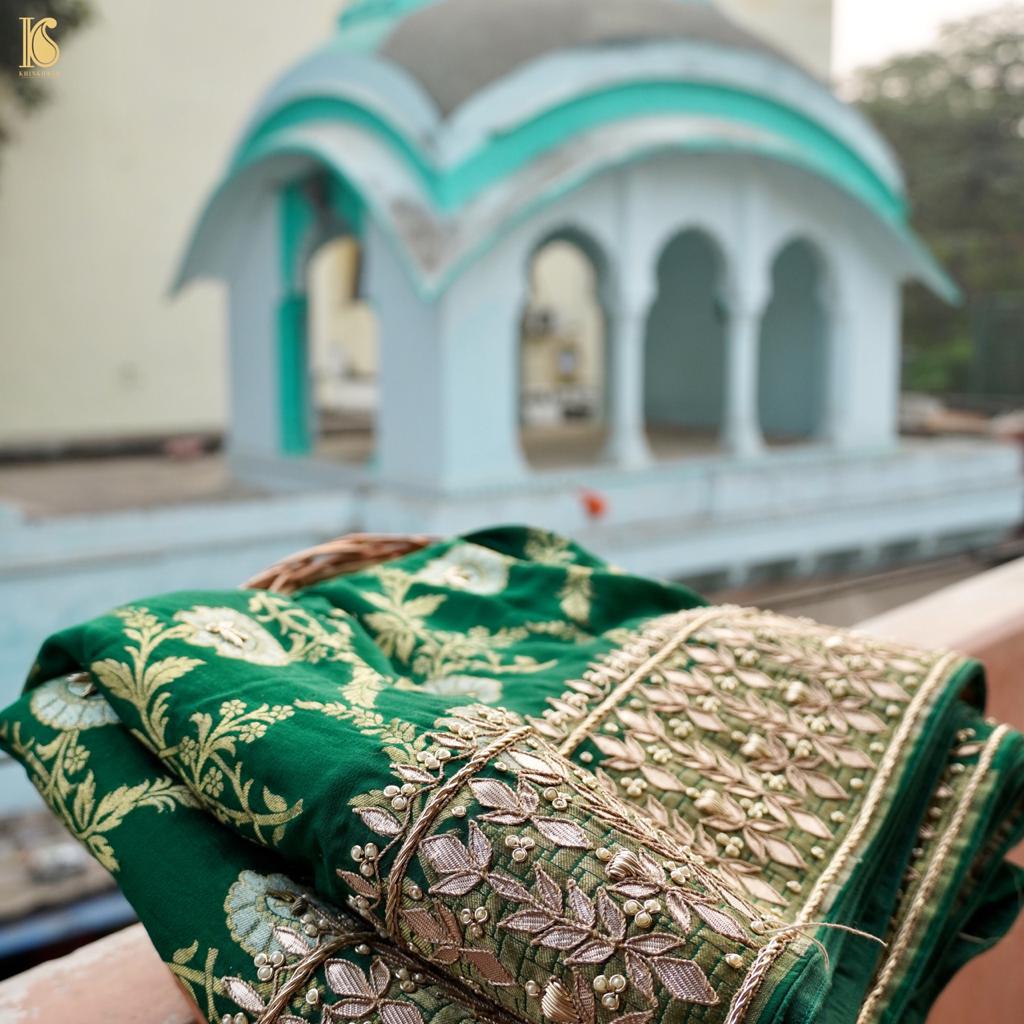India is a melting pot of cultures has always been blessed with different kinds of art and craft. Be it dance forms like Bharatnatyam, Kathak, or Classical and folk music like Rabindra Sangeet, Thumbprint, and Gazal, or be it the intriguing art of embroidery. All these art forms have become an integral part of our rich cultural heritage.
The art of embroidery in India has its own journey and story. Embroidery in India has imbibed the flavors of every culture that came to this land. They can quickly tell you the stories of inventions, settlements, regions, and states. Each region has its own style of impeccable embroideries, which has been there for eras. We have brought to you some of the gorgeous and immensely dynamic embroideries from India:
Mukaish
Originating from the city of Nawabs, Lucknow, Mukaish has been an old source of income and a symbol of the rich culture in the city. Initially crafted and designed for the royalties of Lucknow, this beautiful form of embroidery includes some impressive fine work of thin precious metals like gold and silver. Being an accompaniment to Chikankari, Mukaish work has been used to increase the beauty of Chikankari garments. Still, this form of embroidery can be seen in some of the most beautiful and exclusive wears showcased in the historical places in Lucknow. Mukaish sarees, dupattas, and lehengas are still one of the most popular ones all over the country.

Zardozi
Emerging from one of the ancient lands in the world, Zardozi comes from the country of Persia, now known as Iran. This ravishing form of embroidery also includes the fine work of sewing silver and gold threads on the fabric. Being one of the most expensive forms of work, Zardozi was initially designed for the royals. This work involved the use of not only gold and silver but pearls, stones, and royal fabrics like velvet and silks. During the era of Mughal emperor Akbar, this form of embroidery flourished to its fullest and stayed ever since. Although, the Zardozi work now is being done using a mix of copper wires polished with gold and silver and silk threads, the beauty and the regalness of the work have not changed a bit.

Tilla Embroidery
Another form of embroidery that evolved in the state of Kashmir is the Tilla embroidery. This style was crafted explicitly by using thin threads of silver and gold. It was done on the traditional Kashmiri garment called the Phiran. Soon this royal art became popular among the rich classes. Tilla shawls and sarees were used as a legacy that was passed through the generations. Tilla embroidery is still one of the most celebrated forms of embroidery among the Kashmiris. This beautiful and exclusive art has now won the hearts of millions all over the world.

Chikankari
Another prominent embroidery technique of embroidery from the city of Lucknow, which involves the creation of Chikan work is known as chikankari .Chikan embroidery is mostly done on fabrics like cotton, semi-Georgette, pure Georgette, crepe, chiffon, silk etc. White thread is embroidered on cool, pastel shades of light muslin and cotton garments. Nowadays Chikan embroidery is also done with colored and silk threads in colours to meet the fashion trends and keep chikankari up-to-date..In the recent times Chikan work has adapted additional embellishments like Mukaish, Badla, Bead and mirror work, etc. which gives it a rich look.

Khinkhwab product inspired by Chikankari : Yellow Pure Katan Silk Handloom Banarasi Dupatta

Parsi Gara
When talking about different kinds of embroidery, one cannot miss out on Parsi Gara.Predominantly worn by the Parsi community during weddings and special occasions, the exquisite Gara sari deserves not to be stashed away just for those big days.Even though the sari is covered in silk thread embroidery all over, it has a nice flow to it and can be draped well.Gara sarees are perhaps the most popular example of Parsi embroidery and they have been in demand for their striking exquisite beauty which gradually became symbolic of the Parsi culture and tradition.
The word ‘gara’ means ‘saree’ in Gujarati. Garas went out of fashion in the '30s and were only revived in the '80s. Presently,it is largely used as crepe, as the thread is hand-embroidered.There's definitely an interest and a certain kind of excitement in the younger generation. You can get to see lot of young girls who now say that we want a Gara for their trousseau
Check out our product inspired by Parsi Gara: Plum Purple Pure Katan Silk Handwoven Banarasi Saree with Parsi Gara Jaal

Gota Patti
Rooting from the land of Maharajas, Rajasthan, Gotta Patti is a gorgeous style of embroidery. Decorating royal and glorious lehengas, cholis, kurtas, sarees, and dupattas for the Maharajas and Maharanis, Gotta Patti has been a part of Rajasthani culture for ages. Gota Patti, also known as Lappe ka kaam, is also a type of embroidery done using silver, gold, copper, and other metals. The unique style of Gota work is still a significant source of income in the cities of Bikaner, Jaipur, Ajmer, and Udaipur. Elaborate patterns are created using this beautiful style of embroidery. It is still cherished and is one of the most popular among the brides all over the country.
These beautiful and extraordinary types of embroidery has been a part of our cultural heritage from ages and are going to win hearts for more to come. Enjoy these rich and regal embroidery work from India and make your collection a royal one!
If your looking at buying some Gotta Patti collections from Khinkhwab, our products available are:-
Red Georgette Handloom Banarasi Kadhua Jangla Saree with Gotta Patti

Black Pure Georgette Handloom Banarasi Saree with Exclusive Gotta Patti Work
If you are looking at supporting handmade and buy Handloom Banarasi silk attires online, you can find them all in this one-stop-shop Khinkhwab - The Essence of Banaras
Like and follow us on Social media: Facebook | Instagram | Twitter | Pinterest






